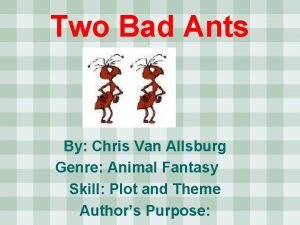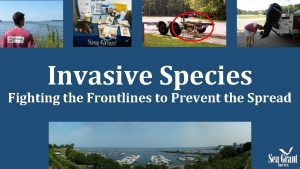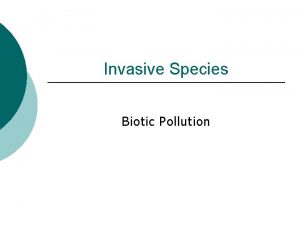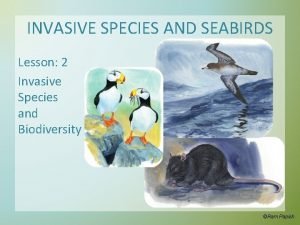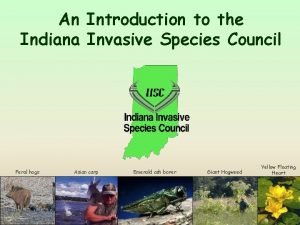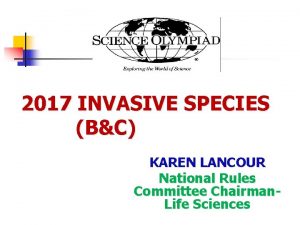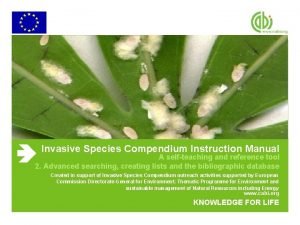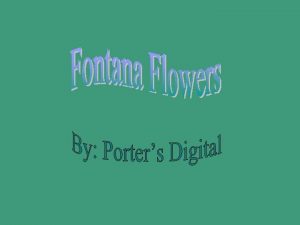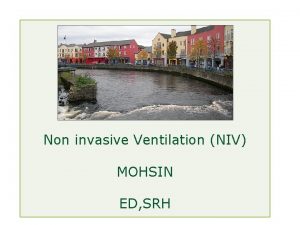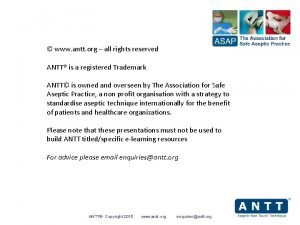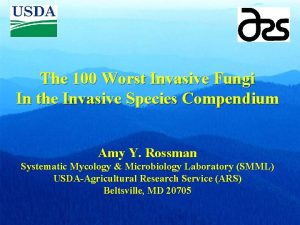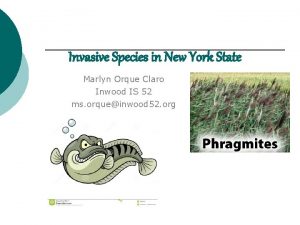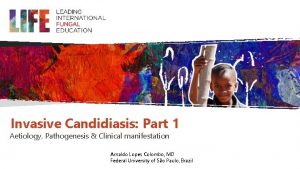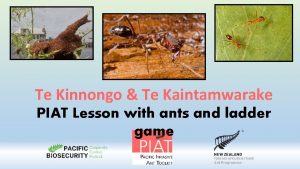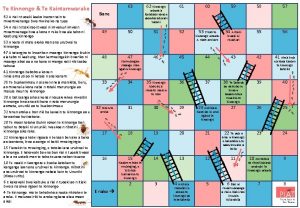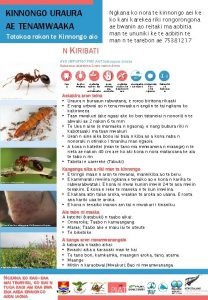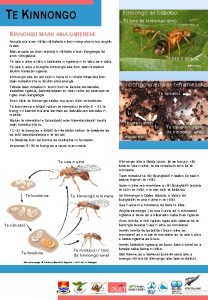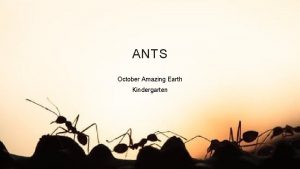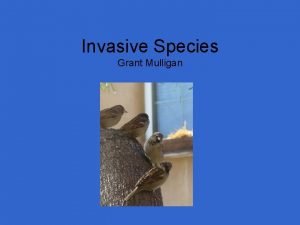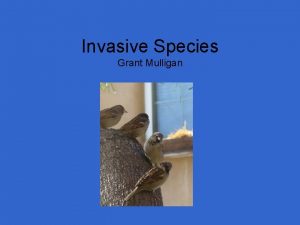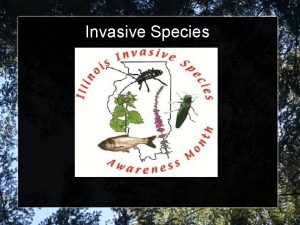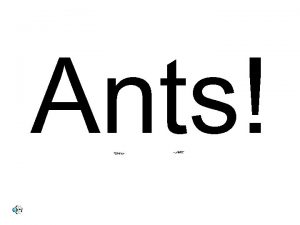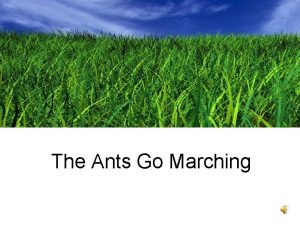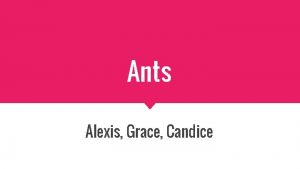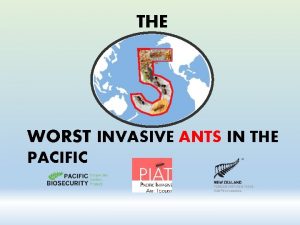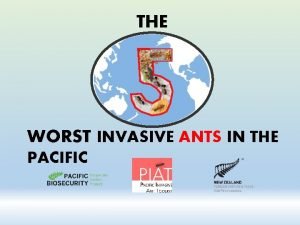Te Kinnongo Te Kaintamwarake Invasive Ants Lesson with


















- Slides: 18

Te Kinnongo & Te Kaintamwarake Invasive Ants Lesson with Ants and Ladder Game

What are we going to learn today? 1) The top five invasive ant pests. 2) The problems they cause to our people, our agriculture and our natural environment. 3) Where these ants come from and how they arrive in our country. 4) What can you do to stop them. Image courtesy of TAW 4 at Free. Digital. Photos. net

Ants / Te Kinnongo? What are they? • Ants are living things. They need air, food and water. • Ants are insects. • They have 3 body parts and 6 legs. • They are in the same family as wasps and bees. • The queen ant can lay thousands of eggs a day.

Ant life cycle Ants go through a number of different stages from egg to adult. They have a 4 stage life-cycle just like the butterfly! One or more queens lay eggs that develop into new workers, queens and males.

What is an invasive ant? An ant that is introduced outside its home range and that damages the natural environment of its new home. The picture shows red imported fire ants travelling over floodwaters on an uprooted tree.

The five WORST invasive ANTS in the Pacific African big-headed ant Red imported fire ant Little fire ant Argentine ant Yellow crazy ant You can’t tell just by looking at these five ant species that they cause worse problems than any other ants

Why are some ants bad? Clockwise from left: A little fire ant biting; skin rash caused by yellow crazy ants; Sea bird chick covered by African big-headed ants; a child stung on the cheek by a fire ant; ants ‘farm’ scale insects, which damage crops.

! o N Are all ants invasive? • Only some introduced ants cause problems. • Some ants are only bad in great numbers. • Most ants do good things for the environment. They cycle nutrients in soil and eat the larvae of household pests like flies and cockroaches. The ant in the picture is called a trap jaw ant. It has been introduced into the Pacific but does not cause problems (although it can bite!)

Activity Time! We are going to play Ants and Ladders! Te Kinnongo & Te Kaintamwarake

Te Kinnongo & Te Kaintamwarake 62 A riai n tuoaki kaako inanon tain te mwamwananga bwa mwina ko na tuaa 54 A riai n itiaki raoi bwaai ni mwakuri imwain mwamwanaga bwa a kona n reke bwa aia tabo ni kaabung kinnongo 53 A kona ni mate aroka man ana urubwai te kinnongo 47 A tatangira te bwariko n maange kinnongo ibukin aia tabo ni kaabung. Man kamwaingakin bwariko ni maange aikai ao a na kona ni manga rotii riki taabo tabeua 41 Kinnongo babobo a kona n ninia am auti ao ni kataia n ana kanam 35 Te buakonimaiu n ai aron nneia manikiba, beru, ao mwanai a kona naba n rotaki marurungia ao maiuia iroun te kinnongo 38 A bati aanga aika a kona n kauarerekea mwaitin kinnongo bwa ana aki kona n rota marurungia aomata, ununiki ao te buakonimaeu 32 Nnen aroka e bon riki ba kawain te kinnongo ao e kawaekoa butinakona. 28 Te moan totoko ibukin rokon te kinnongo bon taben te Botaki ni Ununiki. Waekoa n ribotini kinnongo aika raka. 22 Kinnongo a katei ngaoia n tenaan ben ake a boka ao iaontano, bwa a aonga ni baitii mwaingingia 15 Tianakin te mwainging, e totokoi ana urubwai te kinnongo. E kakawaki ba ena bon riai n tuoaki bwaai ake a na uotaki man te tabo teuana nakon teuana 10 Te waaki n kaongora e buoka katokan te kanganga iaon ana urubwai te kinnongo. Riibotini ana urubwai te kinnongo nakoia kain te Ununiki (Biosecurity). 6 E kakawaki bwa kaibuke a riai n tuoaki ao n itiaki bwa a na akea ngaon te kinnongo 4 Te kinnongo ma te beka a roota rikiraken te aroka. E maiuraoi riki te aroka ngkana akea maan aikai 63 62 Kinnongo 61 60 59 58 57 50 51 52 53 E bati te kinnongo uraura. A mate arokam 54 A itiaki 55 56 47 46 45 44 43 42 41 Akea bwa ea kanam te kinnongo babobo 33 34 35 Kinnongo 36 37 38 Te tararua 39 40 32 Nnen te 31 30 29 28 Aobitia a kunei ao ni urui ngaon te kinnongo 27 26 25 17 18 19 20 21 22 Te uea n aine n kinnongo e kakaraba n te naan ben ake a boka 23 24 15 14 13 12 11 10 Aomata a na ribootina ana urubwai te Kinnongo uraura 9 2 3 4 Aroka a maiuraoi n akean te kinnongo ao tebeka 5 6 Bao ni mwamwananga a riai n itiaki raoi imwain tokarakiia 7 8 Bane 49 48 aroka 16 E nako Kamwaingan maange man ngaon kinnongo Kauarerekean te mwainging, e totokoa butinakon te kinnongo uraura a karabaia inanon uaanikai aika aki tuoaki babobo a rinnako inanon te okai bwaai ni mwakuri ae nakoraoi e kona n kauarerekea mwaitin te kinnongo

Rules • Each player puts their counter on the space that says ‘Start'. • Take it in turns to roll the dice. Move your counter forward the number of spaces shown on the dice. • If your counter lands at the bottom of a ladder, you can move up to the top of the ladder after you have read the information to your friends. • If your counter lands on an ant trail, you must slide down to the bottom of the trail after you have read the information to your friends. • The first player to get to the space that says ‘Finish' is the winner.

Te Kinnongo & Te Kaintamwarake 62 A riai n tuoaki kaako inanon tain te mwamwananga bwa mwina ko na tuaa 54 A riai n itiaki raoi bwaai ni mwakuri imwain mwamwanaga bwa a kona n reke bwa aia tabo ni kaabung kinnongo 53 A kona ni mate aroka man ana urubwai te kinnongo 47 A tatangira te bwariko n maange kinnongo ibukin aia tabo ni kaabung. Man kamwaingakin bwariko ni maange aikai ao a na kona ni manga rotii riki taabo tabeua 41 Kinnongo babobo a kona n ninia am auti ao ni kataia n ana kanam 35 Te buakonimaiu n ai aron nneia manikiba, beru, ao mwanai a kona naba n rotaki marurungia ao maiuia iroun te kinnongo 38 A bati aanga aika a kona n kauarerekea mwaitin kinnongo bwa ana aki kona n rota marurungia aomata, ununiki ao te buakonimaeu 32 Nnen aroka e bon riki ba kawain te kinnongo ao e kawaekoa butinakona. 28 Te moan totoko ibukin rokon te kinnongo bon taben te Botaki ni Ununiki. Waekoa n ribotini kinnongo aika raka. 22 Kinnongo a katei ngaoia n tenaan ben ake a boka ao iaontano, bwa a aonga ni baitii mwaingingia 15 Tianakin te mwainging, e totokoi ana urubwai te kinnongo. E kakawaki ba ena bon riai n tuoaki bwaai ake a na uotaki man te tabo teuana nakon teuana 10 Te waaki n kaongora e buoka katokan te kanganga iaon ana urubwai te kinnongo. Riibotini ana urubwai te kinnongo nakoia kain te Ununiki (Biosecurity). 6 E kakawaki bwa kaibuke a riai n tuoaki ao n itiaki bwa a na akea ngaon te kinnongo 4 Te kinnongo ma te beka a roota rikiraken te aroka. E maiuraoi riki te aroka ngkana akea maan aikai 63 62 Kinnongo 61 60 59 58 57 50 51 52 53 E bati te kinnongo uraura. A mate arokam 54 A itiaki 55 56 47 46 45 44 43 42 41 Akea bwa ea kanam te kinnongo babobo 33 34 35 Kinnongo 36 37 38 Te tararua 39 40 32 Nnen te 31 30 29 28 Aobitia a kunei ao ni urui ngaon te kinnongo 27 26 25 17 18 19 20 21 22 Te uea n aine n kinnongo e kakaraba n te naan ben ake a boka 23 24 15 14 13 12 11 10 Aomata a na ribootina ana urubwai te Kinnongo uraura 9 2 3 4 Aroka a maiuraoi n akean te kinnongo ao tebeka 5 6 Bao ni mwamwananga a riai n itiaki raoi imwain tokarakiia 7 8 Bane 49 48 aroka 16 E nako Kamwaingan maange man ngaon kinnongo Kauarerekean te mwainging, e totokoa butinakon te kinnongo uraura a karabaia inanon uaanikai aika aki tuoaki babobo a rinnako inanon te okai bwaai ni mwakuri ae nakoraoi e kona n kauarerekea mwaitin te kinnongo

Ladders – positive actions (Kiribati) • 54 A riai n itiaki raoi bwaai ni mwakuri imwain mwamwanaga bwa a kona n reke bwa aia tabo ni kaabung kinnongo • 38 A bati aanga aika a kona n kauarerekea mwaitin kinnongo bwa ana aki kona n rota marurungia aomata, ununiki ao te buakonimaeu • 28 Te moan totoko ibukin rokon te kinnongo bon taben te Botaki ni Ununiki. Waekoa n ribotini kinnongo aika raka. • 22 Kinnongo a katei ngaoia n tenaan ben ake a boka ao iaontano, bwa a aonga ni baitii mwaingingia • 15 Tianakin te mwainging, e totokoi ana urubwai te kinnongo. E kakawaki ba ena bon riai n tuoaki bwaai ake a na uotaki man te tabo teuana nakon teuana • 10 Te waaki n kaongora e buoka katokan te kanganga iaon ana urubwai te kinnongo. Riibotini ana urubwai te kinnongo nakoia kain te Ununiki (Biosecurity). • 6 E kakawaki bwa kaibuke a riai n tuoaki ao n itiaki bwa a na akea ngaon te kinnongo • 4 Te kinnongo ma te beka a roota rikiraken te aroka. E maiuraoi riki te aroka ngkana akea maan aikai

Ants – negative actions (Kiribati) • 62 A riai n tuoaki kaako inanon tain te mwamwananga bwa mwina ko na tuaa • 53 A kona ni mate aroka man ana urubwai te kinnongo • 47 A tatangira te bwariko n maange kinnongo ibukin aia tabo ni kaabung. Man kamwaingakin bwariko ni maange aikai ao a na kona ni manga rotii riki taabo tabeua • 41 Kinnongo babobo a kona n ninia am auti ao ni kataia n ana kanam • 35 Te buakonimaiu n ai aron nneia manikiba, beru, ao mwanai a kona naba n rotaki marurungia ao maiuia iroun te kinnongo • 32 Nnen aroka e bon riki ba kawain te kinnongo ao e kawaekoa butinakona. • 22 Kinnongo a katei ngaoia n tenaan ben ake a boka ao iaontano, bwa a aonga ni baitii mwaingingia

Ladders – positive actions (English) • 54 Items of machinery have lots of small spaces that ants can nest in. Machinery should be treated with insecticides, or at least cleaned well before being moved between islands. • 38 There are ways to reduce numbers of ants so that they don’t have effects on people, agriculture and wildlife. • 28 Biosecurity officers are the first line of protection against invasive ants. Help them do their job by reporting any ants that you think are a problem. • 22 Little fire ants are so small that a whole colony can nest in a Macadamia nut. Other ants, such as yellow crazy ants, love nesting in rotting coconuts. • 15 Movement controls are the first step in preventing invasive ants spreading. It is very important to pay attention to these controls and not move risk items (plants, rubbish, machinery), without first having them approved. • 10 A little awareness can help stop ant problems. Report any ants that you think are a problem to biosecurity officers. • 6 Vehicles have lots of small spaces that ants can nest in. They should be checked and cleaned before being moved between islands. • 4 Ants ‘farm’ plant pests such as mealybugs and scale insects, which can reduce plant growth. Plants grow better without these pests.

Ants – negative actions (English) • 62 When travelling it is important to declare high risk items. Not declaring biosecurity risk items (such as fresh fruit) can result in a fine in many nations in the Pacific. • 53 Little fire ants have a nasty sting which makes it difficult to harvest crops. Some people in French Polynesia have even abandoned their land because of little fire ants. • 47 Ants love nesting in rubbish piles (and piles of decaying coconuts and plants). Moving these items provides a way of ants invading new places. • 41 In Tokelau yellow crazy ants invaded homes and even tried to take food off people’s plates before they had a chance to eat. • 35 Wildlife such as lizards, land birds and sea birds and crabs are at great risk from ants. They ants can kill the animals directly or make them leave the area. • 32 A very important ‘pathway’ for little fire ants in Hawaii is potted plants from nurseries. These ants can spread very easily this way. Make sure to get plants from areas not infested with ants. • 22 Little fire ants are so small that a whole colony can nest in a Macadamia nut. Other ants, such as yellow crazy ants, love nesting in rotting coconuts.

What we have learnt today • Ants are insects. They have 3 body parts and 6 legs. • An ant is invasive when it has left its home range and damages the natural environment of its new home. • Not all ants are invasive. Most do good things for the environment like helping decomposition. • Some ants are bad because they can cause harm to our farms, human and our environment. • Ants enter the country in many ways. Everyone must work together for biosecurity. Image courtesy of TAW 4 at Free. Digital. Photos. net

See you next time! Tekeraoi am bong! Image courtesy of arztsamui at Free. Digital. Photos. net
 Lesson from ant
Lesson from ant Two bad ants summary
Two bad ants summary Naturalized species definition
Naturalized species definition Invasive ductal carcinoma with medullary features
Invasive ductal carcinoma with medullary features Characteristics of invasive species
Characteristics of invasive species Invasive species characteristics
Invasive species characteristics Invasive species characteristics
Invasive species characteristics Indiana invasive species council
Indiana invasive species council Invasive species characteristics
Invasive species characteristics Doc for invasive aspergillosis
Doc for invasive aspergillosis Non invasive halo brace
Non invasive halo brace Invasive species compendium
Invasive species compendium Sesleria autumnalis spacing
Sesleria autumnalis spacing Non invasive ventilation
Non invasive ventilation Non invasive ventilation
Non invasive ventilation What is the aim of antt for all invasive procedures
What is the aim of antt for all invasive procedures Invasive mushroom species
Invasive mushroom species Invasive species investigator worksheet
Invasive species investigator worksheet Invasive candidiasis
Invasive candidiasis

